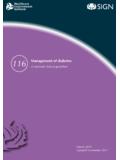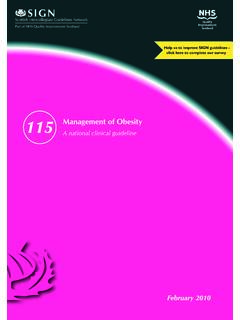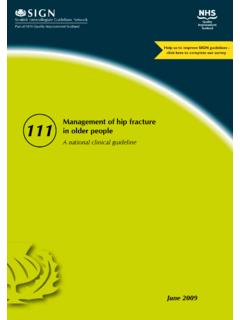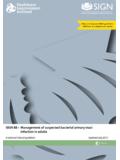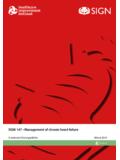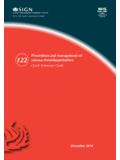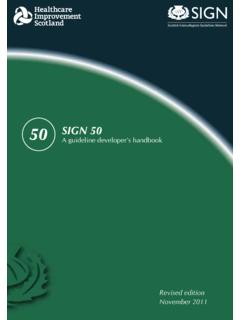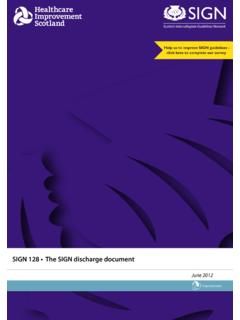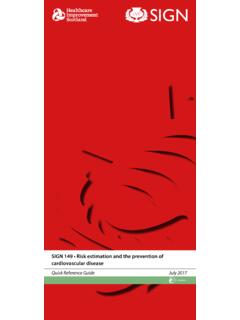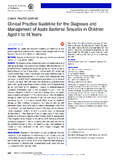Transcription of A national clinical guideline
1 Management of chronic venous leg ulcers A national clinical guidelineAugust 2010120 KEY TO EVIDENCE STATEMENTS AND GRADES OF RECOMMENDATIONSLEVELS OF EVIDENCE1++High quality meta-analyses, systematic reviews of RCTs, or RCTs with a very low risk of bias1+Well conducted meta-analyses, systematic reviews, or RCTs with a low risk of bias1 -Meta-analyses, systematic reviews, or RCTs with a high risk of bias2++ High quality systematic reviews of case control or cohort studies High quality case control or cohort studies with a very low risk of confounding or bias and a high probability that the relationship is causal2+Well conducted case control or cohort studies with a low risk of confounding or bias and a moderate probability that the relationship is causal2 - Case control or cohort studies with a high risk of confounding or bias and a significant risk that the relationship is not causal3 Non-analytic studies, eg case reports, case series4 Expert opinionGRADES OF RECOMMENDATIONNote: The grade of recommendation relates to the strength of the evidence on which the recommendation is based.
2 It does not reflect the clinical importance of the At least one meta-analysis, systematic review, or RCT rated as 1++, and directly applicable to the target population; or A body of evidence consisting principally of studies rated as 1+, directly applicable to the target population, and demonstrating overall consistency of resultsBA body of evidence including studies rated as 2++, directly applicable to the target population, and demonstrating overall consistency of results; orExtrapolated evidence from studies rated as 1++ or 1+CA body of evidence including studies rated as 2+, directly applicable to the target population and demonstrating overall consistency of results; orExtrapolated evidence from studies rated as 2++DEvidence level 3 or 4; orExtrapolated evidence from studies rated as 2+GOOD PRACTICE POINTS Recommended best practice based on the clinical experience of the guideline development groupNHS Evidence has accredited the process used by Scottish Intercollegiate guidelines Network to produce guidelines .
3 Accreditation is valid for three years from 2009 and is applicable to guidance produced using the processes described in SIGN 50: a guideline developer s handbook, 2008 edition ( ). More information on accreditation can be viewed at Quality Improvement Scotland (NHS QIS) is committed to equality and diversity and assesses all its publications for likely impact on the six equality groups defined by age, disability, gender, race, religion/belief and sexual guidelines are produced using a standard methodology that has been equality impact assessed to ensure that these equality aims are addressed in every guideline . This methodology is set out in the current version of SIGN 50, our guideline manual, which can be found at The EQIA assessment of the manual can be seen at The full report in paper form and/or alternative format is available on request from the NHS QIS Equality and Diversity care is taken to ensure that this publication is correct in every detail at the time of publication.
4 However, in the event of errors or omissions corrections will be published in the web version of this document, which is the definitive version at all times. This version can be found on our web site This document is produced from elemental chlorine-free material and is sourced from sustainable Intercollegiate guidelines NetworkManagement of chronic venous leg ulcers A national clinical guidelineThis guideline is dedicated to the memory of Dr Susan MorleyAugust 2010 ManageMent of chronic venous leg ulcersisBn 978 1 905813 66 7 Published august 2010 This guideline was issued in 2010 and will be considered for review in three years. The review history, and any updates to the guideline in the interim period, will be noted in the review report, which is available in the supporting material section for this guideline on the SIGN website: consents to the photocopying of this guideline for the purpose of implementation in NHSS cotlandscottish intercollegiate guidelines network healthcare improvement scotland gyle square, 1 south gyle crescent edinburgh eh12 Introduction.
5 Background .. Updating the evidence .. Statement of intent ..22 Key recommendations .. Treatment .. Preventing ulcer Provision of care ..43 Assessment .. Assessing the patient .. Assessing the leg .. Assessing the ulcer .. Re-assessment .. Criteria for specialist referral ..84 Treatment .. Introduction .. Cleansing and debridement .. Dressings .. Surrounding skin .. Compression .. Systemic therapy .. Analgesia .. Skin grafting .. Other therapies .. Venous surgery .. Lifestyle Preventing ulcer recurrence .. Graduated compression for healed venous ulceration .. Venous surgery ..196 Provision of care .. Background .. Training .. Specialist leg ulcer clinics .. Leg clubs ..21 MANAGEMENT OF CHRONIC VENOUS LEG ULCERS7 Provision of information .. Checklist for provision of information .. Sources of further information .. Sample information Implementing the guideline .
6 Auditing current practice .. Recommendations with potential resource implications ..269 The evidence base .. Systematic literature review .. Recommendations for research .. Review and updating ..2710 Development of the guideline .. Introduction .. The guideline development group .. Consultation and peer review ..29 Abbreviations ..31 Annexes ..32 References ..38 MANAGEMENT OF CHRONIC VENOUS LEG ULCERS11 INTRODUCTION1 BACKGROUNDV enous ulceration is the most common type of leg ulceration. Sixty to 80% of leg ulcers have a venous The Lothian and Forth Valley Study examined 600 patients with leg ulceration and found that 76% of ulcerated legs had evidence of venous disease and 22% had evidence of arterial disease. Ten to 20% of cases had both arterial and venous insufficiency. Nine per cent of ulcerated legs were in patients with rheumatoid arthritis. Five per cent of the patient group had venous leg ulceration has an estimated prevalence of between and in the United ,9 Prevalence increases with Approximately 1% of the population will suffer from leg ulceration at some point in their ulcers arise from venous valve incompetence and calf muscle pump insufficiency which leads to venous stasis and hypertension.
7 This results in microcirculatory changes and localised tissue ,12 The natural history of the disease is of a continuous cycle of healing and breakdown over decades and chronic venous leg ulcers are associated with considerable morbidity and impaired quality of Leg ulcers in patients from the most deprived communities (social classes IV and V) take longer to heal and are more likely to be of this major health problem results in a considerable cost to the NHS. The cost of treating one ulcer was estimated to be between 1,298 and 1,526 per year based on 2001 prices and in the context of a trial conducted within a specialist leg ulcer THE NEED FOR A GUIDELINEE vidence of variation in both healing rates and recurrence rates of venous leg ulcers highlights the need for an updated evidence based guideline to support practice. Healing rates in the community, where 80% of patients are treated, are low compared to rates in specialist clinics.
8 In the Scottish Leg Ulcer Trial, the six months healing rate for community based treatment was 45%.16 In specialist clinics (see section ), healing rates of around 70% at six months have been Twelve month recurrence rates vary between 26% and 69%. REMIT OF THE GUIDELINEThis guideline provides evidence based recommendations on the management of venous leg ulcers and examines assessment, treatment and the prevention of recurrence. Evidence on provision of care is also presented. The guideline does not cover detailed management of patients with chronic leg ulcer in the specialist fields of diabetes, vascular surgery or rheumatoid disease, although indications for referral are DEFINITIONIn this guideline , chronic venous leg ulcer is defined as an open lesion between the knee and the ankle joint that remains unhealed for at least four weeks and occurs in the presence of venous disease.
9 Studies reviewed in this guideline included patients with venous leg ulcers, irrespective of the method of diagnosis of venous TARGET USERS OF THE GUIDELINEThis guideline will be of particular interest to patients, general practitioners (GPs), nursing staff (district nurses, practice nurses and specialist nurses in dermatology, wound management, tissue viability and rheumatology) dermatologists, vascular surgeons and plastic surgeons, as well as pharmacists. It may also be of interest to podiatrists and OF CHRONIC VENOUS LEG UPDATING THE EVIDENCEThis guideline updates SIGN 26 to reflect the most recent evidence on chronic venous leg ulceration. Where no significant new evidence was identified to support an update, text and recommendations are reproduced from SIGN 26. The original supporting evidence was not re-appraised by the current guideline development group.
10 The key questions used to develop this guideline are displayed in Annex evidence in SIGN 26 was appraised using an earlier grading system. Details of how the grading system was translated to SIGN s current grading system are available on the SIGN website ( ). SUMMARY OF UPDATES TO THE GUIDELINE1 IntroductionMinor update2 Key recommendationsNew3 Assessment - The ankle brachial pressure index ( ) and dermatitis/eczema ( )Minor update4 TreatmentCompletely revised5 PreventionCompletely revised6 Provision of care - Specialist leg ulcer clinics ( )Minor update7 Provision of informationNew8 Implementing the guidelineMinor STATEMENT OF INTENT This guideline is not intended to be construed or to serve as a standard of care. Standards of care are determined on the basis of all clinical data available for an individual case and are subject to change as scientific knowledge and technology advance and patterns of care evolve.
